Reflective Essay: Aboriginal Workplace Challenges and Strategies
VerifiedAdded on 2022/08/10
|11
|2796
|86
Essay
AI Summary
This reflective essay examines the significant challenges Aboriginal peoples face in the Australian workplace. It delves into historical injustices, including the impact of European settlement, dispossession of land, and the Stolen Generations, and how these events have shaped employment disparities and created intergenerational trauma. The essay analyzes the effects of political and social influences, such as the Close the Gap policy and the ongoing issue of labour market discrimination. It explores the challenges of low wages, poor working conditions, and racism, while also highlighting positive initiatives such as the Aboriginal Employment Strategy. The essay proposes practical actions to foster positive and respectful outcomes, including traineeship programs, inclusive workplace policies, cultural competency training, and encouraging greater understanding and respect from non-Indigenous Australians. The aim is to promote equitable employment opportunities and improve the well-being of Aboriginal and Torres Strait Islander peoples.
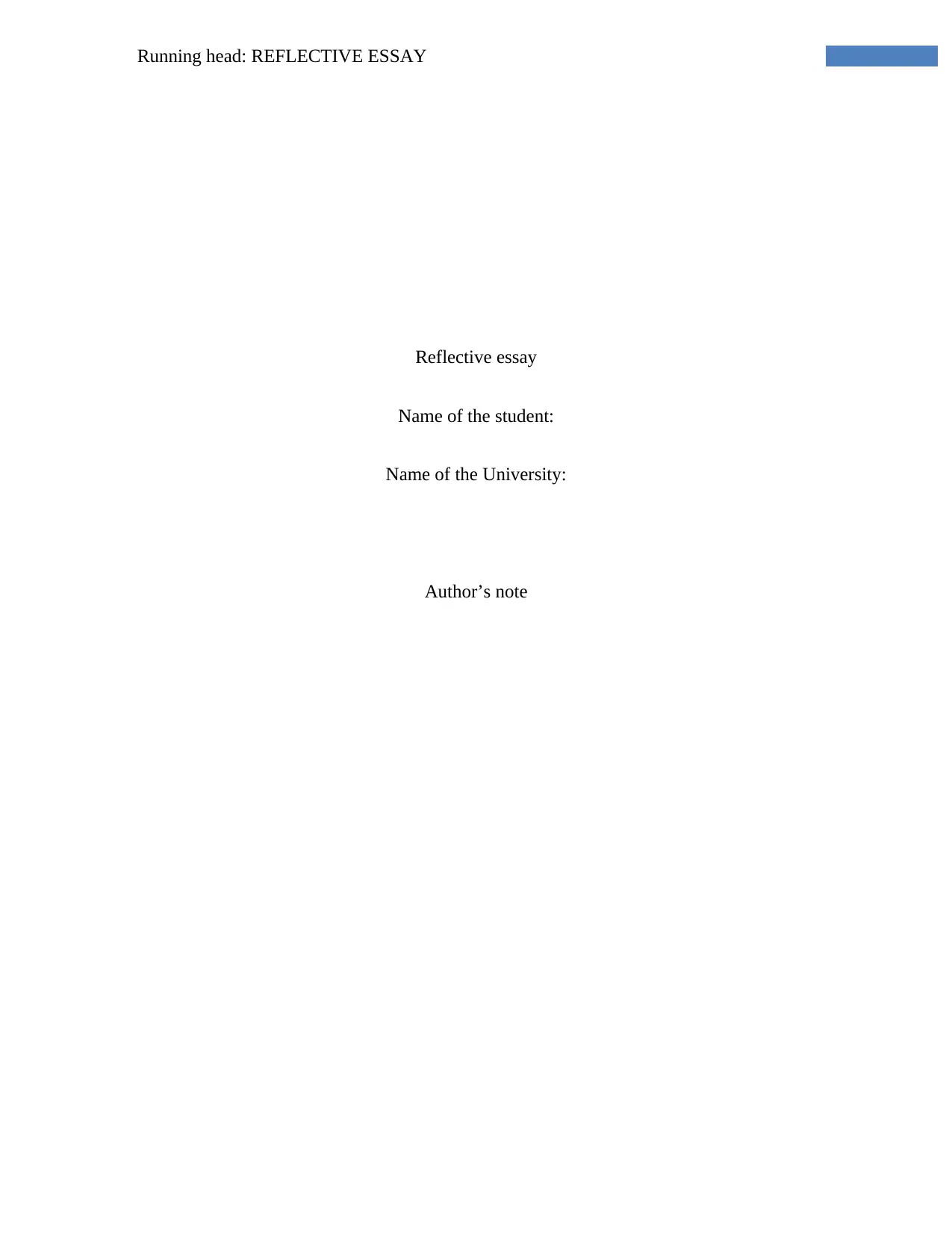
Running head: REFLECTIVE ESSAY
Reflective essay
Name of the student:
Name of the University:
Author’s note
Reflective essay
Name of the student:
Name of the University:
Author’s note
Paraphrase This Document
Need a fresh take? Get an instant paraphrase of this document with our AI Paraphraser
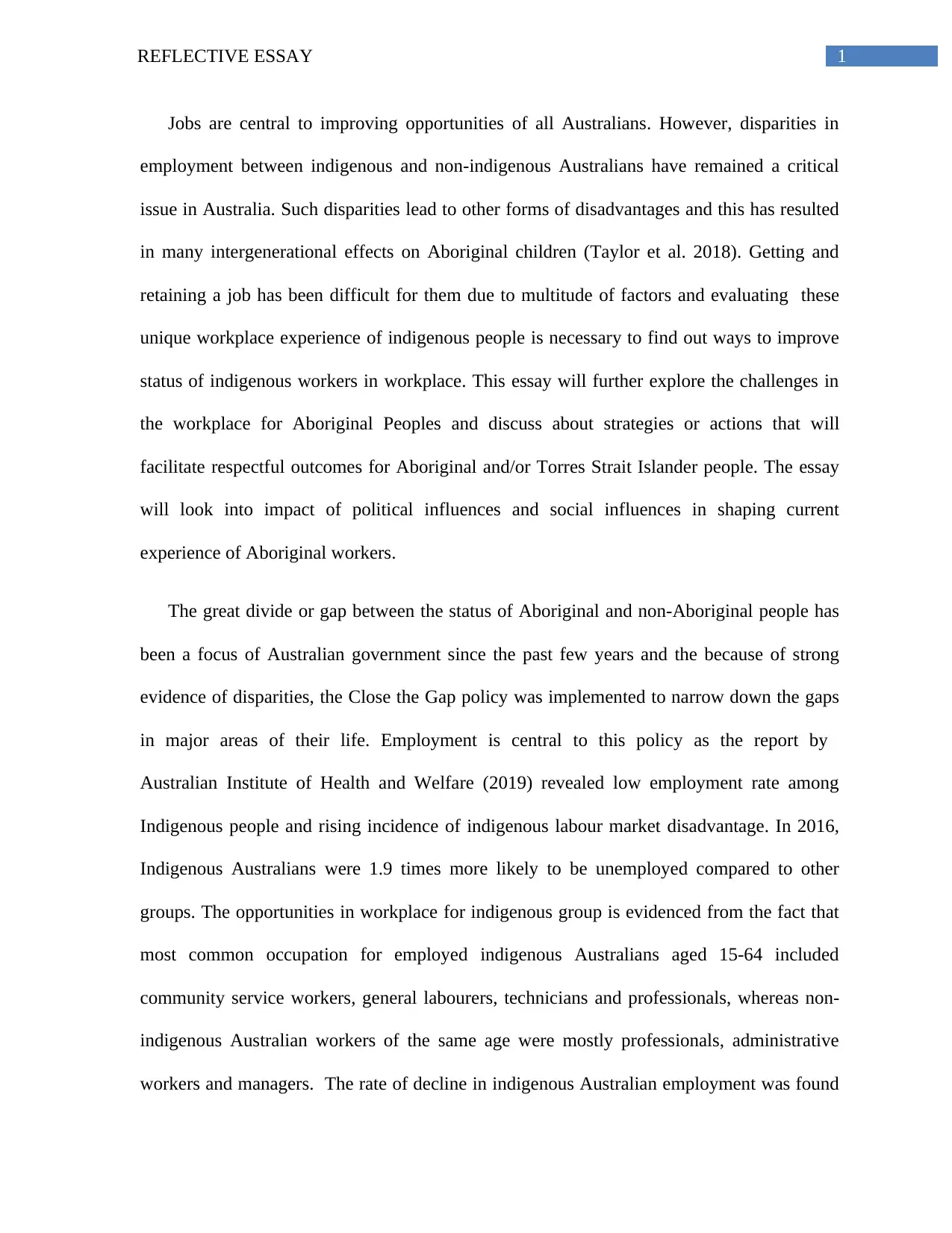
1REFLECTIVE ESSAY
Jobs are central to improving opportunities of all Australians. However, disparities in
employment between indigenous and non-indigenous Australians have remained a critical
issue in Australia. Such disparities lead to other forms of disadvantages and this has resulted
in many intergenerational effects on Aboriginal children (Taylor et al. 2018). Getting and
retaining a job has been difficult for them due to multitude of factors and evaluating these
unique workplace experience of indigenous people is necessary to find out ways to improve
status of indigenous workers in workplace. This essay will further explore the challenges in
the workplace for Aboriginal Peoples and discuss about strategies or actions that will
facilitate respectful outcomes for Aboriginal and/or Torres Strait Islander people. The essay
will look into impact of political influences and social influences in shaping current
experience of Aboriginal workers.
The great divide or gap between the status of Aboriginal and non-Aboriginal people has
been a focus of Australian government since the past few years and the because of strong
evidence of disparities, the Close the Gap policy was implemented to narrow down the gaps
in major areas of their life. Employment is central to this policy as the report by
Australian Institute of Health and Welfare (2019) revealed low employment rate among
Indigenous people and rising incidence of indigenous labour market disadvantage. In 2016,
Indigenous Australians were 1.9 times more likely to be unemployed compared to other
groups. The opportunities in workplace for indigenous group is evidenced from the fact that
most common occupation for employed indigenous Australians aged 15-64 included
community service workers, general labourers, technicians and professionals, whereas non-
indigenous Australian workers of the same age were mostly professionals, administrative
workers and managers. The rate of decline in indigenous Australian employment was found
Jobs are central to improving opportunities of all Australians. However, disparities in
employment between indigenous and non-indigenous Australians have remained a critical
issue in Australia. Such disparities lead to other forms of disadvantages and this has resulted
in many intergenerational effects on Aboriginal children (Taylor et al. 2018). Getting and
retaining a job has been difficult for them due to multitude of factors and evaluating these
unique workplace experience of indigenous people is necessary to find out ways to improve
status of indigenous workers in workplace. This essay will further explore the challenges in
the workplace for Aboriginal Peoples and discuss about strategies or actions that will
facilitate respectful outcomes for Aboriginal and/or Torres Strait Islander people. The essay
will look into impact of political influences and social influences in shaping current
experience of Aboriginal workers.
The great divide or gap between the status of Aboriginal and non-Aboriginal people has
been a focus of Australian government since the past few years and the because of strong
evidence of disparities, the Close the Gap policy was implemented to narrow down the gaps
in major areas of their life. Employment is central to this policy as the report by
Australian Institute of Health and Welfare (2019) revealed low employment rate among
Indigenous people and rising incidence of indigenous labour market disadvantage. In 2016,
Indigenous Australians were 1.9 times more likely to be unemployed compared to other
groups. The opportunities in workplace for indigenous group is evidenced from the fact that
most common occupation for employed indigenous Australians aged 15-64 included
community service workers, general labourers, technicians and professionals, whereas non-
indigenous Australian workers of the same age were mostly professionals, administrative
workers and managers. The rate of decline in indigenous Australian employment was found
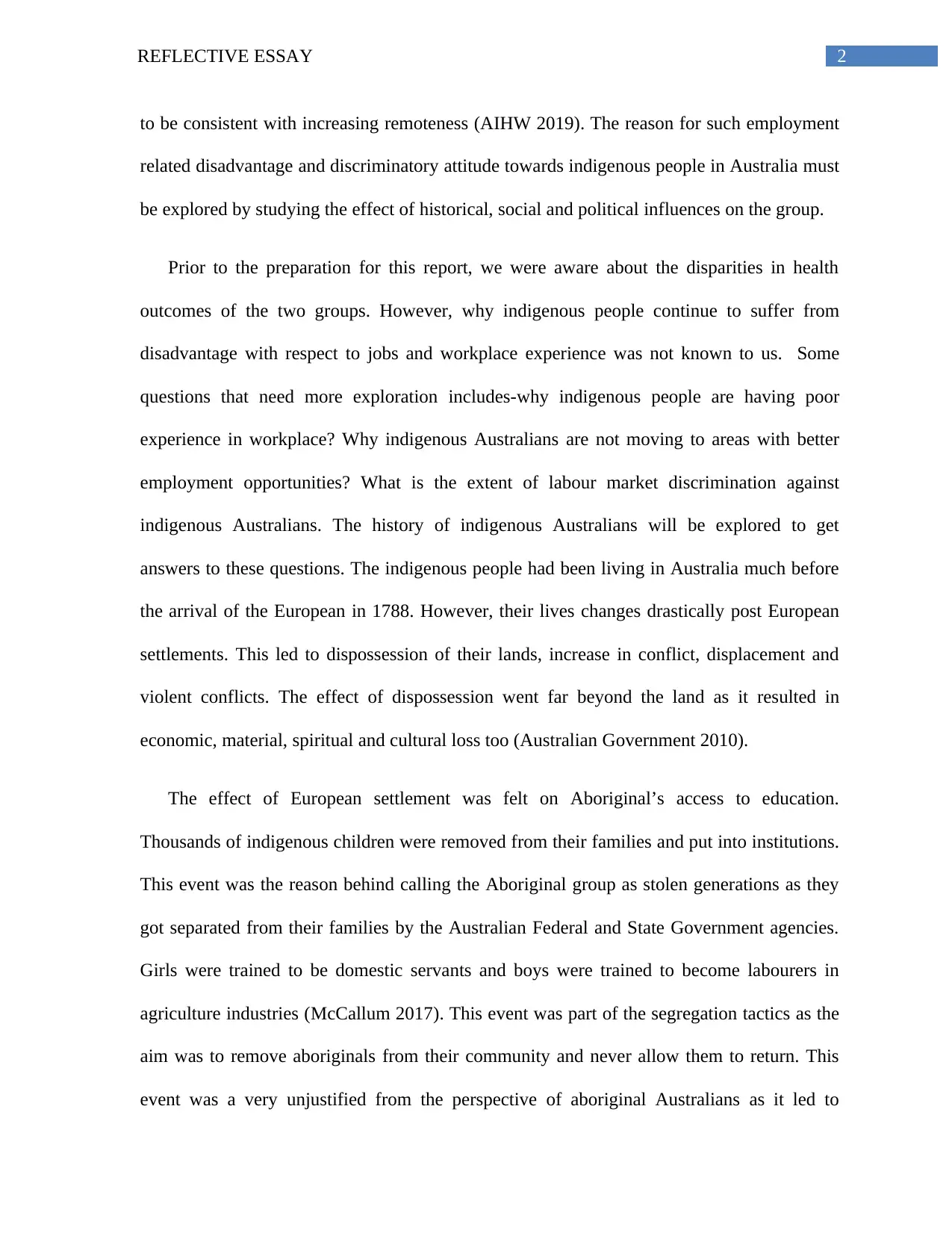
2REFLECTIVE ESSAY
to be consistent with increasing remoteness (AIHW 2019). The reason for such employment
related disadvantage and discriminatory attitude towards indigenous people in Australia must
be explored by studying the effect of historical, social and political influences on the group.
Prior to the preparation for this report, we were aware about the disparities in health
outcomes of the two groups. However, why indigenous people continue to suffer from
disadvantage with respect to jobs and workplace experience was not known to us. Some
questions that need more exploration includes-why indigenous people are having poor
experience in workplace? Why indigenous Australians are not moving to areas with better
employment opportunities? What is the extent of labour market discrimination against
indigenous Australians. The history of indigenous Australians will be explored to get
answers to these questions. The indigenous people had been living in Australia much before
the arrival of the European in 1788. However, their lives changes drastically post European
settlements. This led to dispossession of their lands, increase in conflict, displacement and
violent conflicts. The effect of dispossession went far beyond the land as it resulted in
economic, material, spiritual and cultural loss too (Australian Government 2010).
The effect of European settlement was felt on Aboriginal’s access to education.
Thousands of indigenous children were removed from their families and put into institutions.
This event was the reason behind calling the Aboriginal group as stolen generations as they
got separated from their families by the Australian Federal and State Government agencies.
Girls were trained to be domestic servants and boys were trained to become labourers in
agriculture industries (McCallum 2017). This event was part of the segregation tactics as the
aim was to remove aboriginals from their community and never allow them to return. This
event was a very unjustified from the perspective of aboriginal Australians as it led to
to be consistent with increasing remoteness (AIHW 2019). The reason for such employment
related disadvantage and discriminatory attitude towards indigenous people in Australia must
be explored by studying the effect of historical, social and political influences on the group.
Prior to the preparation for this report, we were aware about the disparities in health
outcomes of the two groups. However, why indigenous people continue to suffer from
disadvantage with respect to jobs and workplace experience was not known to us. Some
questions that need more exploration includes-why indigenous people are having poor
experience in workplace? Why indigenous Australians are not moving to areas with better
employment opportunities? What is the extent of labour market discrimination against
indigenous Australians. The history of indigenous Australians will be explored to get
answers to these questions. The indigenous people had been living in Australia much before
the arrival of the European in 1788. However, their lives changes drastically post European
settlements. This led to dispossession of their lands, increase in conflict, displacement and
violent conflicts. The effect of dispossession went far beyond the land as it resulted in
economic, material, spiritual and cultural loss too (Australian Government 2010).
The effect of European settlement was felt on Aboriginal’s access to education.
Thousands of indigenous children were removed from their families and put into institutions.
This event was the reason behind calling the Aboriginal group as stolen generations as they
got separated from their families by the Australian Federal and State Government agencies.
Girls were trained to be domestic servants and boys were trained to become labourers in
agriculture industries (McCallum 2017). This event was part of the segregation tactics as the
aim was to remove aboriginals from their community and never allow them to return. This
event was a very unjustified from the perspective of aboriginal Australians as it led to
⊘ This is a preview!⊘
Do you want full access?
Subscribe today to unlock all pages.

Trusted by 1+ million students worldwide
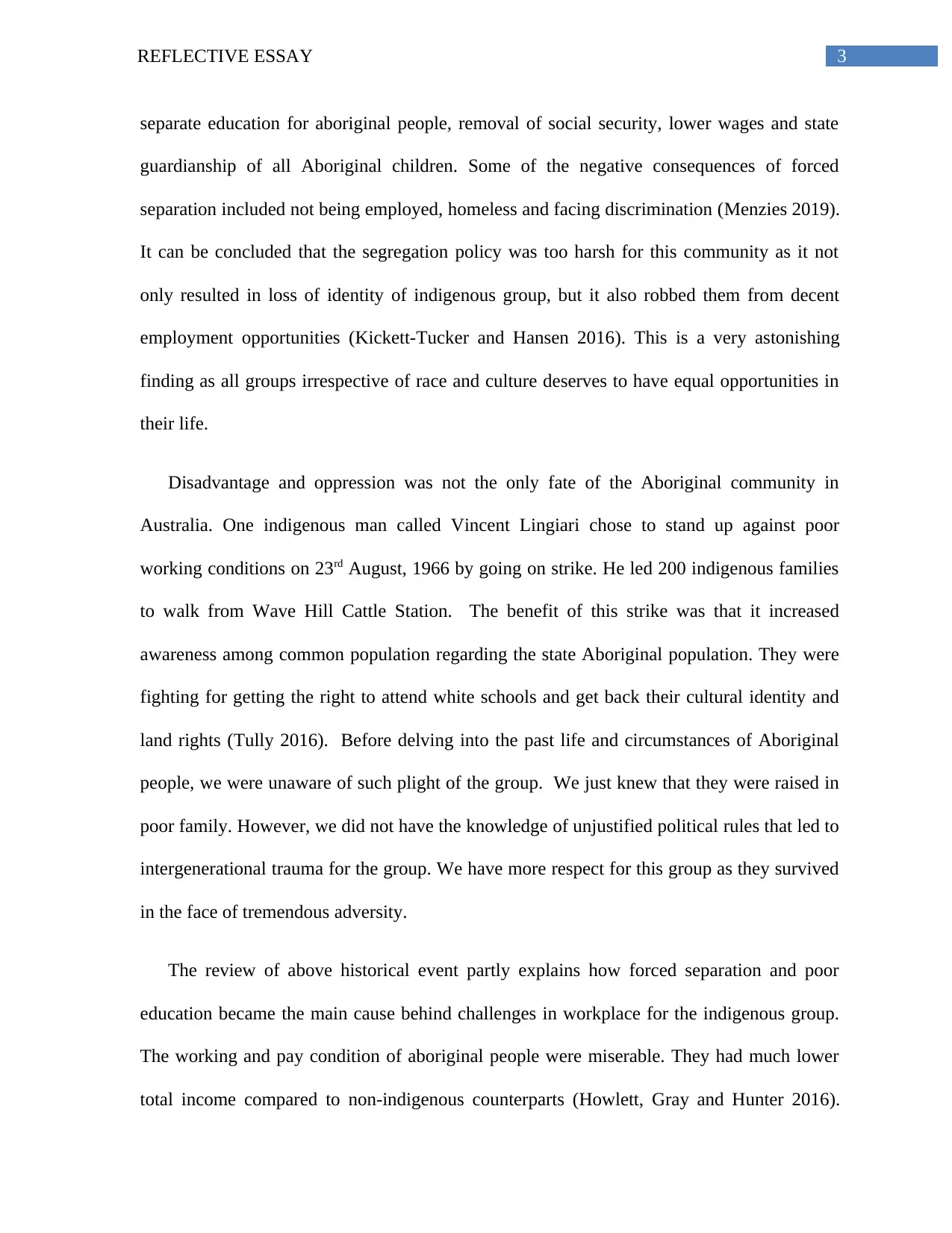
3REFLECTIVE ESSAY
separate education for aboriginal people, removal of social security, lower wages and state
guardianship of all Aboriginal children. Some of the negative consequences of forced
separation included not being employed, homeless and facing discrimination (Menzies 2019).
It can be concluded that the segregation policy was too harsh for this community as it not
only resulted in loss of identity of indigenous group, but it also robbed them from decent
employment opportunities (Kickett-Tucker and Hansen 2016). This is a very astonishing
finding as all groups irrespective of race and culture deserves to have equal opportunities in
their life.
Disadvantage and oppression was not the only fate of the Aboriginal community in
Australia. One indigenous man called Vincent Lingiari chose to stand up against poor
working conditions on 23rd August, 1966 by going on strike. He led 200 indigenous families
to walk from Wave Hill Cattle Station. The benefit of this strike was that it increased
awareness among common population regarding the state Aboriginal population. They were
fighting for getting the right to attend white schools and get back their cultural identity and
land rights (Tully 2016). Before delving into the past life and circumstances of Aboriginal
people, we were unaware of such plight of the group. We just knew that they were raised in
poor family. However, we did not have the knowledge of unjustified political rules that led to
intergenerational trauma for the group. We have more respect for this group as they survived
in the face of tremendous adversity.
The review of above historical event partly explains how forced separation and poor
education became the main cause behind challenges in workplace for the indigenous group.
The working and pay condition of aboriginal people were miserable. They had much lower
total income compared to non-indigenous counterparts (Howlett, Gray and Hunter 2016).
separate education for aboriginal people, removal of social security, lower wages and state
guardianship of all Aboriginal children. Some of the negative consequences of forced
separation included not being employed, homeless and facing discrimination (Menzies 2019).
It can be concluded that the segregation policy was too harsh for this community as it not
only resulted in loss of identity of indigenous group, but it also robbed them from decent
employment opportunities (Kickett-Tucker and Hansen 2016). This is a very astonishing
finding as all groups irrespective of race and culture deserves to have equal opportunities in
their life.
Disadvantage and oppression was not the only fate of the Aboriginal community in
Australia. One indigenous man called Vincent Lingiari chose to stand up against poor
working conditions on 23rd August, 1966 by going on strike. He led 200 indigenous families
to walk from Wave Hill Cattle Station. The benefit of this strike was that it increased
awareness among common population regarding the state Aboriginal population. They were
fighting for getting the right to attend white schools and get back their cultural identity and
land rights (Tully 2016). Before delving into the past life and circumstances of Aboriginal
people, we were unaware of such plight of the group. We just knew that they were raised in
poor family. However, we did not have the knowledge of unjustified political rules that led to
intergenerational trauma for the group. We have more respect for this group as they survived
in the face of tremendous adversity.
The review of above historical event partly explains how forced separation and poor
education became the main cause behind challenges in workplace for the indigenous group.
The working and pay condition of aboriginal people were miserable. They had much lower
total income compared to non-indigenous counterparts (Howlett, Gray and Hunter 2016).
Paraphrase This Document
Need a fresh take? Get an instant paraphrase of this document with our AI Paraphraser
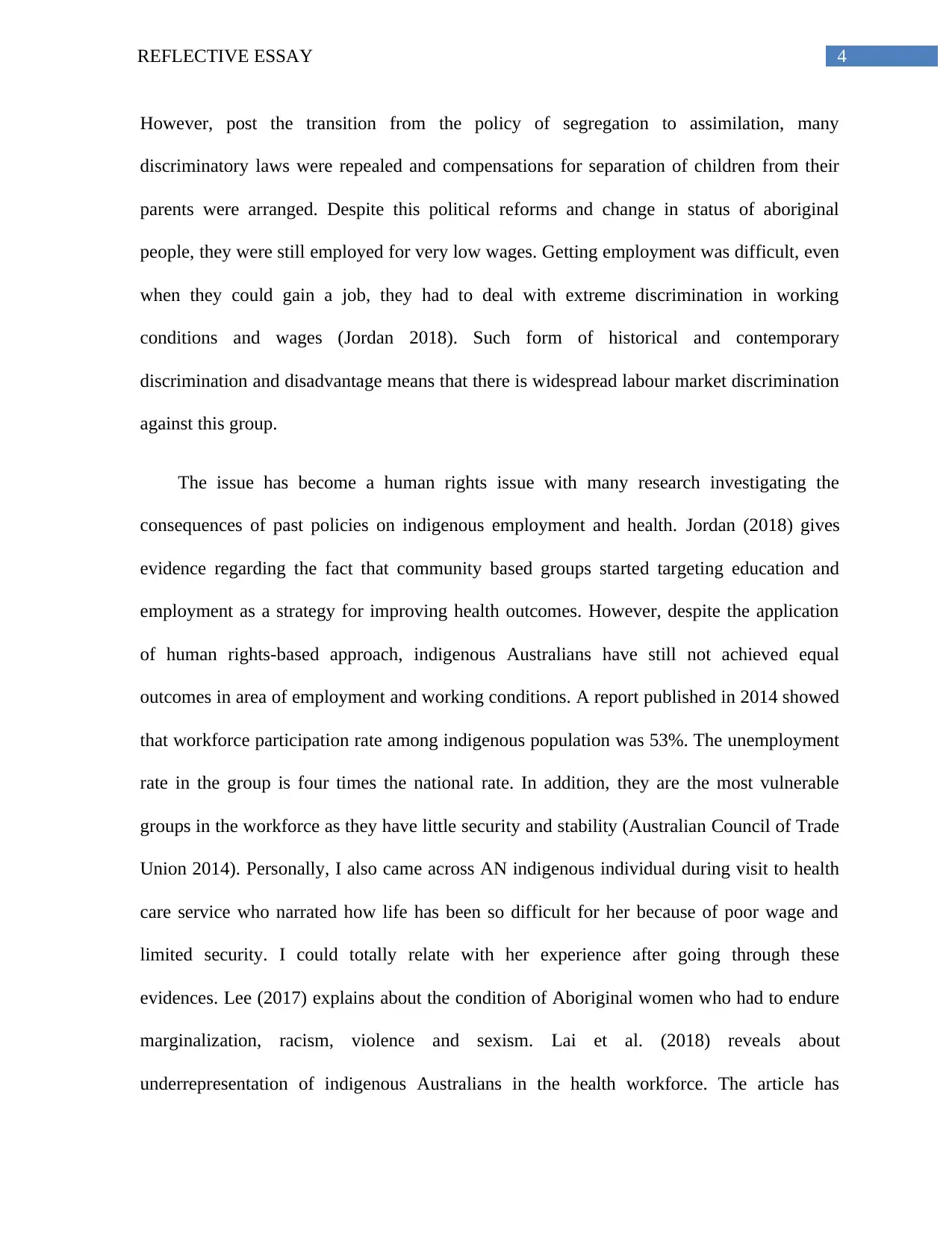
4REFLECTIVE ESSAY
However, post the transition from the policy of segregation to assimilation, many
discriminatory laws were repealed and compensations for separation of children from their
parents were arranged. Despite this political reforms and change in status of aboriginal
people, they were still employed for very low wages. Getting employment was difficult, even
when they could gain a job, they had to deal with extreme discrimination in working
conditions and wages (Jordan 2018). Such form of historical and contemporary
discrimination and disadvantage means that there is widespread labour market discrimination
against this group.
The issue has become a human rights issue with many research investigating the
consequences of past policies on indigenous employment and health. Jordan (2018) gives
evidence regarding the fact that community based groups started targeting education and
employment as a strategy for improving health outcomes. However, despite the application
of human rights-based approach, indigenous Australians have still not achieved equal
outcomes in area of employment and working conditions. A report published in 2014 showed
that workforce participation rate among indigenous population was 53%. The unemployment
rate in the group is four times the national rate. In addition, they are the most vulnerable
groups in the workforce as they have little security and stability (Australian Council of Trade
Union 2014). Personally, I also came across AN indigenous individual during visit to health
care service who narrated how life has been so difficult for her because of poor wage and
limited security. I could totally relate with her experience after going through these
evidences. Lee (2017) explains about the condition of Aboriginal women who had to endure
marginalization, racism, violence and sexism. Lai et al. (2018) reveals about
underrepresentation of indigenous Australians in the health workforce. The article has
However, post the transition from the policy of segregation to assimilation, many
discriminatory laws were repealed and compensations for separation of children from their
parents were arranged. Despite this political reforms and change in status of aboriginal
people, they were still employed for very low wages. Getting employment was difficult, even
when they could gain a job, they had to deal with extreme discrimination in working
conditions and wages (Jordan 2018). Such form of historical and contemporary
discrimination and disadvantage means that there is widespread labour market discrimination
against this group.
The issue has become a human rights issue with many research investigating the
consequences of past policies on indigenous employment and health. Jordan (2018) gives
evidence regarding the fact that community based groups started targeting education and
employment as a strategy for improving health outcomes. However, despite the application
of human rights-based approach, indigenous Australians have still not achieved equal
outcomes in area of employment and working conditions. A report published in 2014 showed
that workforce participation rate among indigenous population was 53%. The unemployment
rate in the group is four times the national rate. In addition, they are the most vulnerable
groups in the workforce as they have little security and stability (Australian Council of Trade
Union 2014). Personally, I also came across AN indigenous individual during visit to health
care service who narrated how life has been so difficult for her because of poor wage and
limited security. I could totally relate with her experience after going through these
evidences. Lee (2017) explains about the condition of Aboriginal women who had to endure
marginalization, racism, violence and sexism. Lai et al. (2018) reveals about
underrepresentation of indigenous Australians in the health workforce. The article has
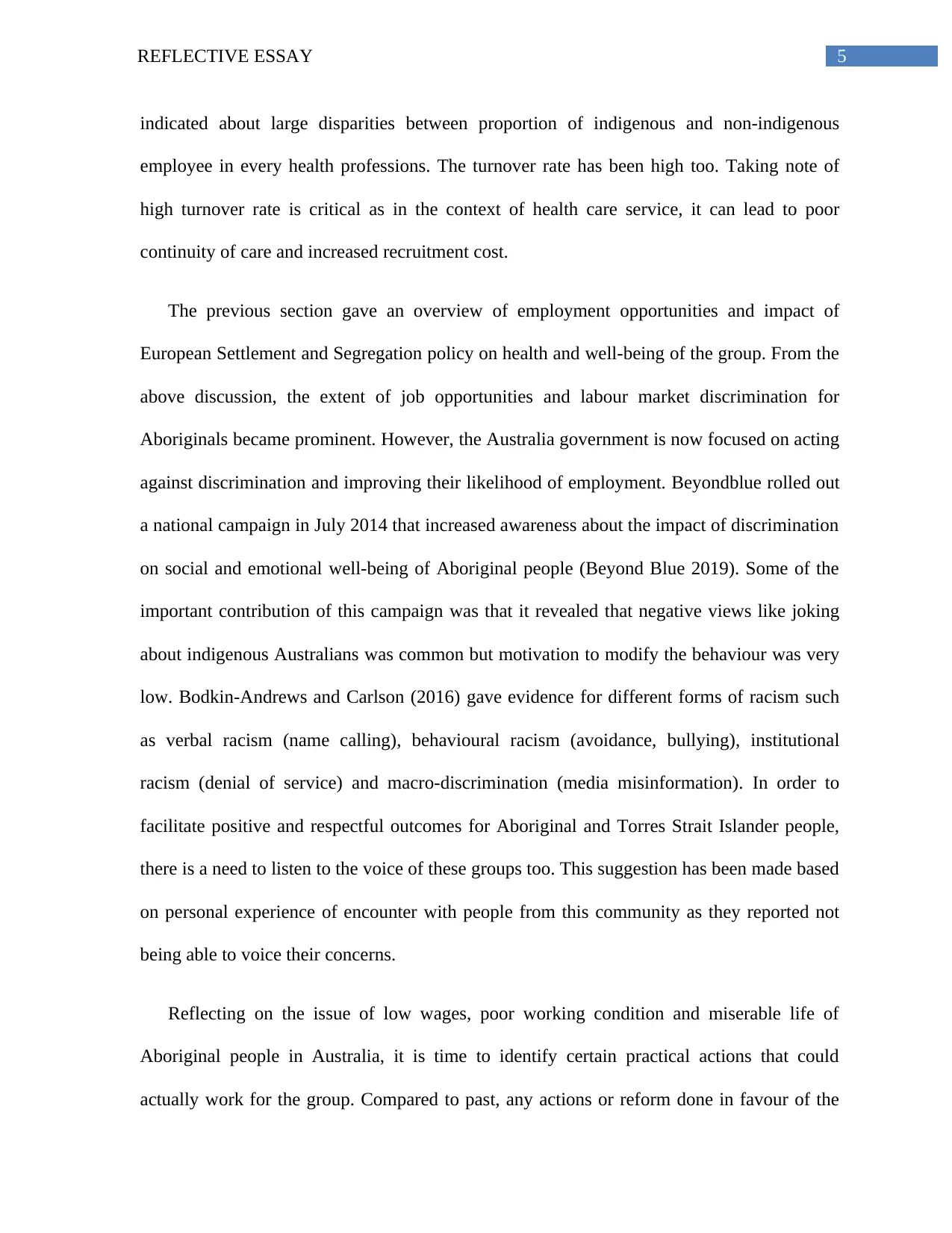
5REFLECTIVE ESSAY
indicated about large disparities between proportion of indigenous and non-indigenous
employee in every health professions. The turnover rate has been high too. Taking note of
high turnover rate is critical as in the context of health care service, it can lead to poor
continuity of care and increased recruitment cost.
The previous section gave an overview of employment opportunities and impact of
European Settlement and Segregation policy on health and well-being of the group. From the
above discussion, the extent of job opportunities and labour market discrimination for
Aboriginals became prominent. However, the Australia government is now focused on acting
against discrimination and improving their likelihood of employment. Beyondblue rolled out
a national campaign in July 2014 that increased awareness about the impact of discrimination
on social and emotional well-being of Aboriginal people (Beyond Blue 2019). Some of the
important contribution of this campaign was that it revealed that negative views like joking
about indigenous Australians was common but motivation to modify the behaviour was very
low. Bodkin-Andrews and Carlson (2016) gave evidence for different forms of racism such
as verbal racism (name calling), behavioural racism (avoidance, bullying), institutional
racism (denial of service) and macro-discrimination (media misinformation). In order to
facilitate positive and respectful outcomes for Aboriginal and Torres Strait Islander people,
there is a need to listen to the voice of these groups too. This suggestion has been made based
on personal experience of encounter with people from this community as they reported not
being able to voice their concerns.
Reflecting on the issue of low wages, poor working condition and miserable life of
Aboriginal people in Australia, it is time to identify certain practical actions that could
actually work for the group. Compared to past, any actions or reform done in favour of the
indicated about large disparities between proportion of indigenous and non-indigenous
employee in every health professions. The turnover rate has been high too. Taking note of
high turnover rate is critical as in the context of health care service, it can lead to poor
continuity of care and increased recruitment cost.
The previous section gave an overview of employment opportunities and impact of
European Settlement and Segregation policy on health and well-being of the group. From the
above discussion, the extent of job opportunities and labour market discrimination for
Aboriginals became prominent. However, the Australia government is now focused on acting
against discrimination and improving their likelihood of employment. Beyondblue rolled out
a national campaign in July 2014 that increased awareness about the impact of discrimination
on social and emotional well-being of Aboriginal people (Beyond Blue 2019). Some of the
important contribution of this campaign was that it revealed that negative views like joking
about indigenous Australians was common but motivation to modify the behaviour was very
low. Bodkin-Andrews and Carlson (2016) gave evidence for different forms of racism such
as verbal racism (name calling), behavioural racism (avoidance, bullying), institutional
racism (denial of service) and macro-discrimination (media misinformation). In order to
facilitate positive and respectful outcomes for Aboriginal and Torres Strait Islander people,
there is a need to listen to the voice of these groups too. This suggestion has been made based
on personal experience of encounter with people from this community as they reported not
being able to voice their concerns.
Reflecting on the issue of low wages, poor working condition and miserable life of
Aboriginal people in Australia, it is time to identify certain practical actions that could
actually work for the group. Compared to past, any actions or reform done in favour of the
⊘ This is a preview!⊘
Do you want full access?
Subscribe today to unlock all pages.

Trusted by 1+ million students worldwide
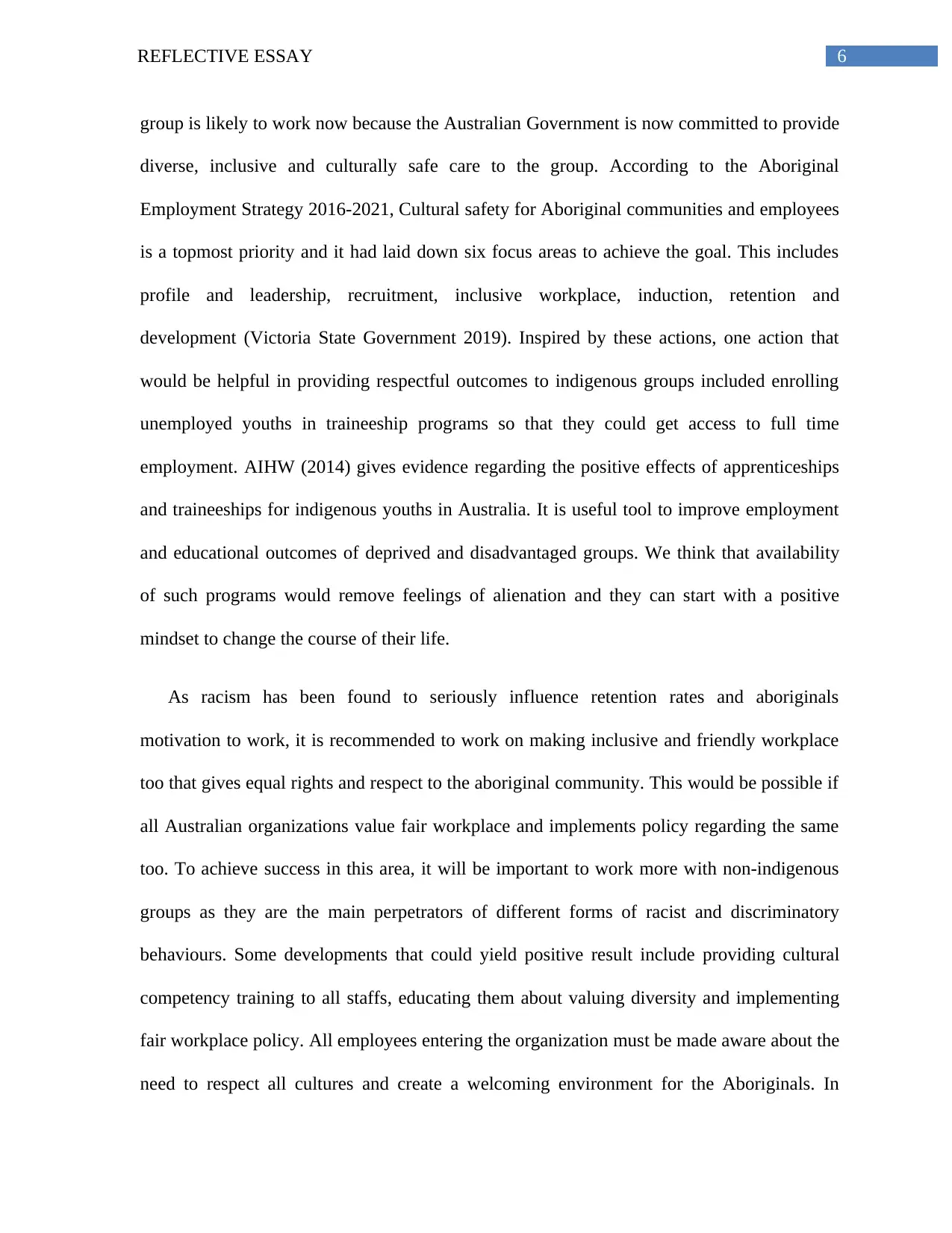
6REFLECTIVE ESSAY
group is likely to work now because the Australian Government is now committed to provide
diverse, inclusive and culturally safe care to the group. According to the Aboriginal
Employment Strategy 2016-2021, Cultural safety for Aboriginal communities and employees
is a topmost priority and it had laid down six focus areas to achieve the goal. This includes
profile and leadership, recruitment, inclusive workplace, induction, retention and
development (Victoria State Government 2019). Inspired by these actions, one action that
would be helpful in providing respectful outcomes to indigenous groups included enrolling
unemployed youths in traineeship programs so that they could get access to full time
employment. AIHW (2014) gives evidence regarding the positive effects of apprenticeships
and traineeships for indigenous youths in Australia. It is useful tool to improve employment
and educational outcomes of deprived and disadvantaged groups. We think that availability
of such programs would remove feelings of alienation and they can start with a positive
mindset to change the course of their life.
As racism has been found to seriously influence retention rates and aboriginals
motivation to work, it is recommended to work on making inclusive and friendly workplace
too that gives equal rights and respect to the aboriginal community. This would be possible if
all Australian organizations value fair workplace and implements policy regarding the same
too. To achieve success in this area, it will be important to work more with non-indigenous
groups as they are the main perpetrators of different forms of racist and discriminatory
behaviours. Some developments that could yield positive result include providing cultural
competency training to all staffs, educating them about valuing diversity and implementing
fair workplace policy. All employees entering the organization must be made aware about the
need to respect all cultures and create a welcoming environment for the Aboriginals. In
group is likely to work now because the Australian Government is now committed to provide
diverse, inclusive and culturally safe care to the group. According to the Aboriginal
Employment Strategy 2016-2021, Cultural safety for Aboriginal communities and employees
is a topmost priority and it had laid down six focus areas to achieve the goal. This includes
profile and leadership, recruitment, inclusive workplace, induction, retention and
development (Victoria State Government 2019). Inspired by these actions, one action that
would be helpful in providing respectful outcomes to indigenous groups included enrolling
unemployed youths in traineeship programs so that they could get access to full time
employment. AIHW (2014) gives evidence regarding the positive effects of apprenticeships
and traineeships for indigenous youths in Australia. It is useful tool to improve employment
and educational outcomes of deprived and disadvantaged groups. We think that availability
of such programs would remove feelings of alienation and they can start with a positive
mindset to change the course of their life.
As racism has been found to seriously influence retention rates and aboriginals
motivation to work, it is recommended to work on making inclusive and friendly workplace
too that gives equal rights and respect to the aboriginal community. This would be possible if
all Australian organizations value fair workplace and implements policy regarding the same
too. To achieve success in this area, it will be important to work more with non-indigenous
groups as they are the main perpetrators of different forms of racist and discriminatory
behaviours. Some developments that could yield positive result include providing cultural
competency training to all staffs, educating them about valuing diversity and implementing
fair workplace policy. All employees entering the organization must be made aware about the
need to respect all cultures and create a welcoming environment for the Aboriginals. In
Paraphrase This Document
Need a fresh take? Get an instant paraphrase of this document with our AI Paraphraser
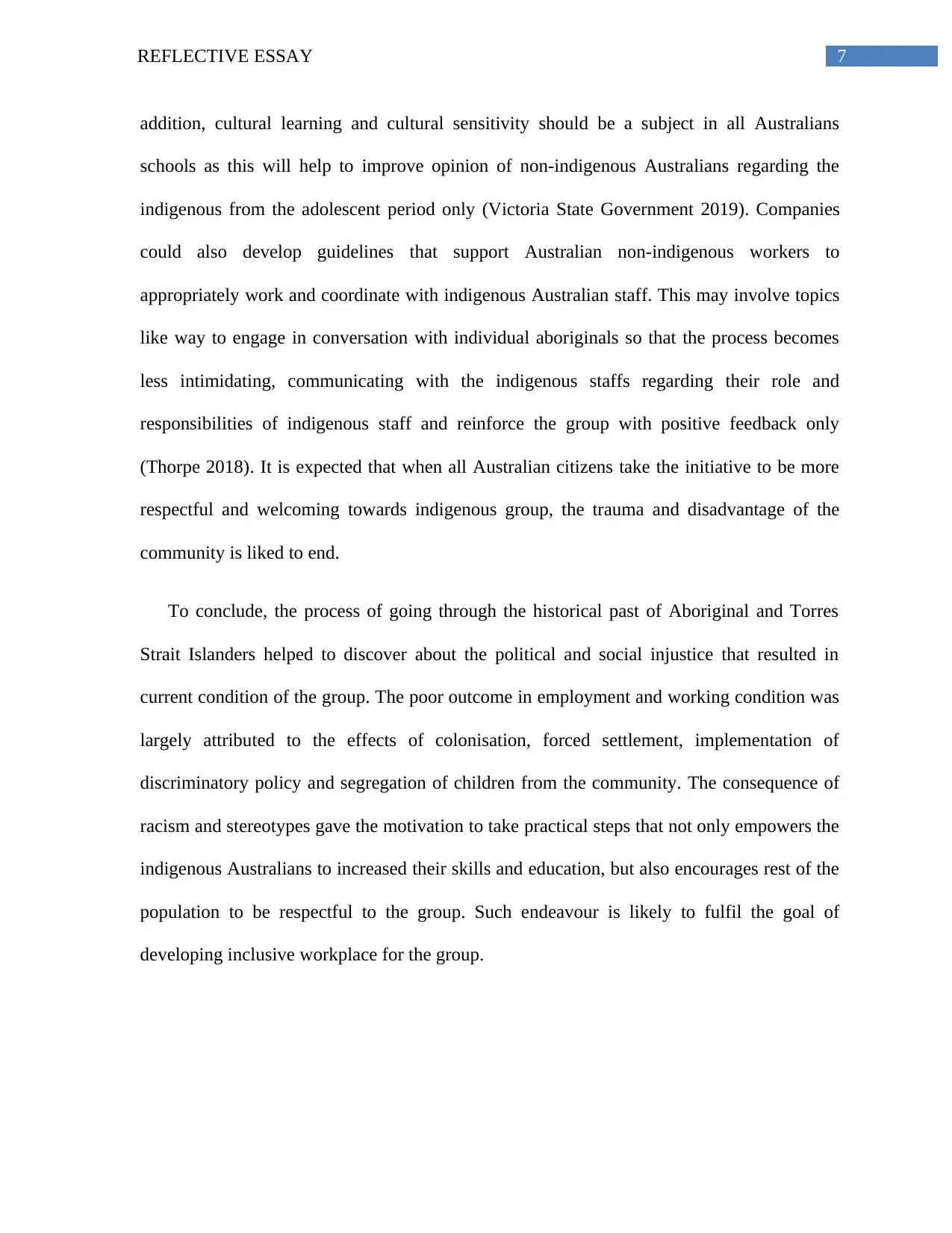
7REFLECTIVE ESSAY
addition, cultural learning and cultural sensitivity should be a subject in all Australians
schools as this will help to improve opinion of non-indigenous Australians regarding the
indigenous from the adolescent period only (Victoria State Government 2019). Companies
could also develop guidelines that support Australian non-indigenous workers to
appropriately work and coordinate with indigenous Australian staff. This may involve topics
like way to engage in conversation with individual aboriginals so that the process becomes
less intimidating, communicating with the indigenous staffs regarding their role and
responsibilities of indigenous staff and reinforce the group with positive feedback only
(Thorpe 2018). It is expected that when all Australian citizens take the initiative to be more
respectful and welcoming towards indigenous group, the trauma and disadvantage of the
community is liked to end.
To conclude, the process of going through the historical past of Aboriginal and Torres
Strait Islanders helped to discover about the political and social injustice that resulted in
current condition of the group. The poor outcome in employment and working condition was
largely attributed to the effects of colonisation, forced settlement, implementation of
discriminatory policy and segregation of children from the community. The consequence of
racism and stereotypes gave the motivation to take practical steps that not only empowers the
indigenous Australians to increased their skills and education, but also encourages rest of the
population to be respectful to the group. Such endeavour is likely to fulfil the goal of
developing inclusive workplace for the group.
addition, cultural learning and cultural sensitivity should be a subject in all Australians
schools as this will help to improve opinion of non-indigenous Australians regarding the
indigenous from the adolescent period only (Victoria State Government 2019). Companies
could also develop guidelines that support Australian non-indigenous workers to
appropriately work and coordinate with indigenous Australian staff. This may involve topics
like way to engage in conversation with individual aboriginals so that the process becomes
less intimidating, communicating with the indigenous staffs regarding their role and
responsibilities of indigenous staff and reinforce the group with positive feedback only
(Thorpe 2018). It is expected that when all Australian citizens take the initiative to be more
respectful and welcoming towards indigenous group, the trauma and disadvantage of the
community is liked to end.
To conclude, the process of going through the historical past of Aboriginal and Torres
Strait Islanders helped to discover about the political and social injustice that resulted in
current condition of the group. The poor outcome in employment and working condition was
largely attributed to the effects of colonisation, forced settlement, implementation of
discriminatory policy and segregation of children from the community. The consequence of
racism and stereotypes gave the motivation to take practical steps that not only empowers the
indigenous Australians to increased their skills and education, but also encourages rest of the
population to be respectful to the group. Such endeavour is likely to fulfil the goal of
developing inclusive workplace for the group.
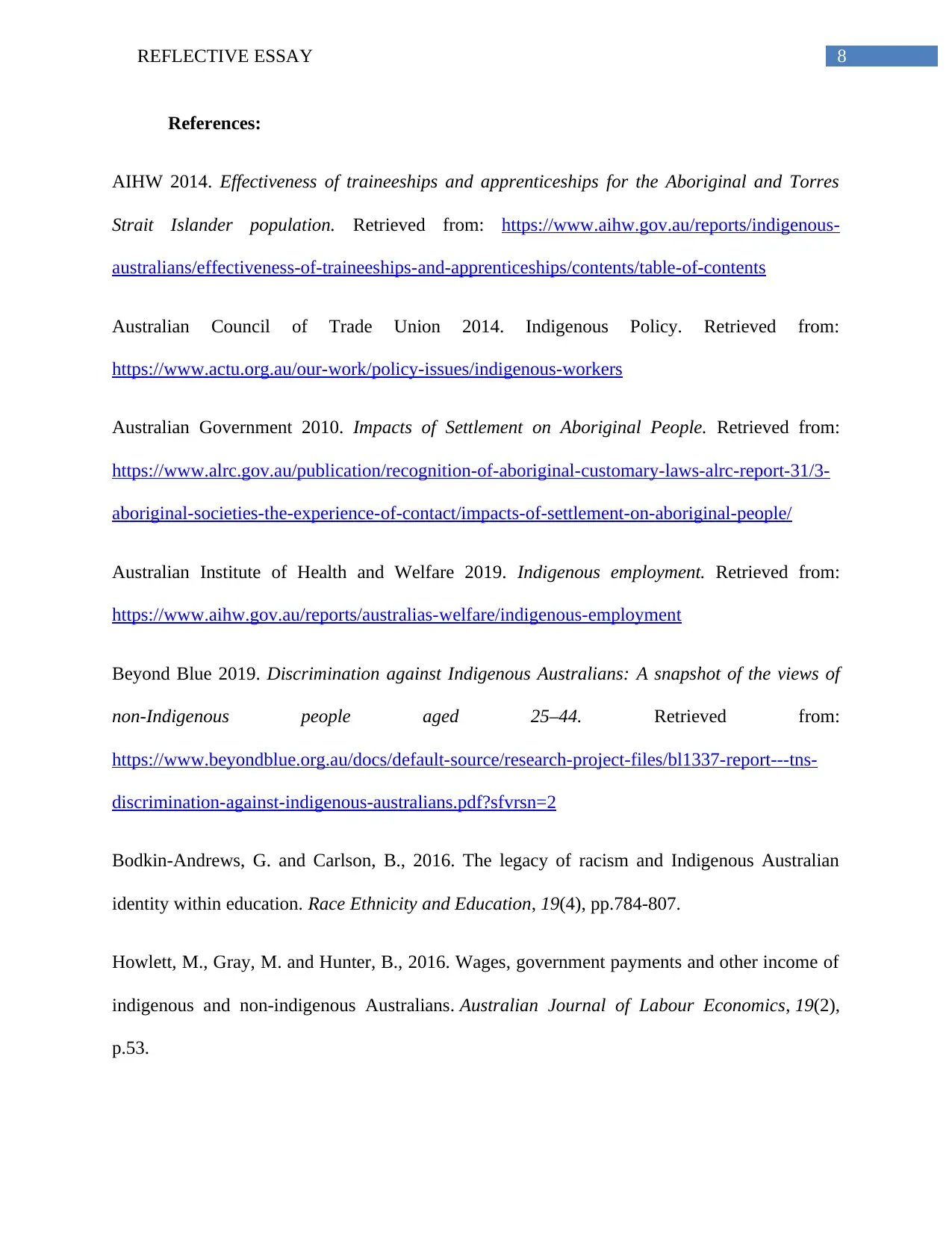
8REFLECTIVE ESSAY
References:
AIHW 2014. Effectiveness of traineeships and apprenticeships for the Aboriginal and Torres
Strait Islander population. Retrieved from: https://www.aihw.gov.au/reports/indigenous-
australians/effectiveness-of-traineeships-and-apprenticeships/contents/table-of-contents
Australian Council of Trade Union 2014. Indigenous Policy. Retrieved from:
https://www.actu.org.au/our-work/policy-issues/indigenous-workers
Australian Government 2010. Impacts of Settlement on Aboriginal People. Retrieved from:
https://www.alrc.gov.au/publication/recognition-of-aboriginal-customary-laws-alrc-report-31/3-
aboriginal-societies-the-experience-of-contact/impacts-of-settlement-on-aboriginal-people/
Australian Institute of Health and Welfare 2019. Indigenous employment. Retrieved from:
https://www.aihw.gov.au/reports/australias-welfare/indigenous-employment
Beyond Blue 2019. Discrimination against Indigenous Australians: A snapshot of the views of
non-Indigenous people aged 25–44. Retrieved from:
https://www.beyondblue.org.au/docs/default-source/research-project-files/bl1337-report---tns-
discrimination-against-indigenous-australians.pdf?sfvrsn=2
Bodkin-Andrews, G. and Carlson, B., 2016. The legacy of racism and Indigenous Australian
identity within education. Race Ethnicity and Education, 19(4), pp.784-807.
Howlett, M., Gray, M. and Hunter, B., 2016. Wages, government payments and other income of
indigenous and non-indigenous Australians. Australian Journal of Labour Economics, 19(2),
p.53.
References:
AIHW 2014. Effectiveness of traineeships and apprenticeships for the Aboriginal and Torres
Strait Islander population. Retrieved from: https://www.aihw.gov.au/reports/indigenous-
australians/effectiveness-of-traineeships-and-apprenticeships/contents/table-of-contents
Australian Council of Trade Union 2014. Indigenous Policy. Retrieved from:
https://www.actu.org.au/our-work/policy-issues/indigenous-workers
Australian Government 2010. Impacts of Settlement on Aboriginal People. Retrieved from:
https://www.alrc.gov.au/publication/recognition-of-aboriginal-customary-laws-alrc-report-31/3-
aboriginal-societies-the-experience-of-contact/impacts-of-settlement-on-aboriginal-people/
Australian Institute of Health and Welfare 2019. Indigenous employment. Retrieved from:
https://www.aihw.gov.au/reports/australias-welfare/indigenous-employment
Beyond Blue 2019. Discrimination against Indigenous Australians: A snapshot of the views of
non-Indigenous people aged 25–44. Retrieved from:
https://www.beyondblue.org.au/docs/default-source/research-project-files/bl1337-report---tns-
discrimination-against-indigenous-australians.pdf?sfvrsn=2
Bodkin-Andrews, G. and Carlson, B., 2016. The legacy of racism and Indigenous Australian
identity within education. Race Ethnicity and Education, 19(4), pp.784-807.
Howlett, M., Gray, M. and Hunter, B., 2016. Wages, government payments and other income of
indigenous and non-indigenous Australians. Australian Journal of Labour Economics, 19(2),
p.53.
⊘ This is a preview!⊘
Do you want full access?
Subscribe today to unlock all pages.

Trusted by 1+ million students worldwide
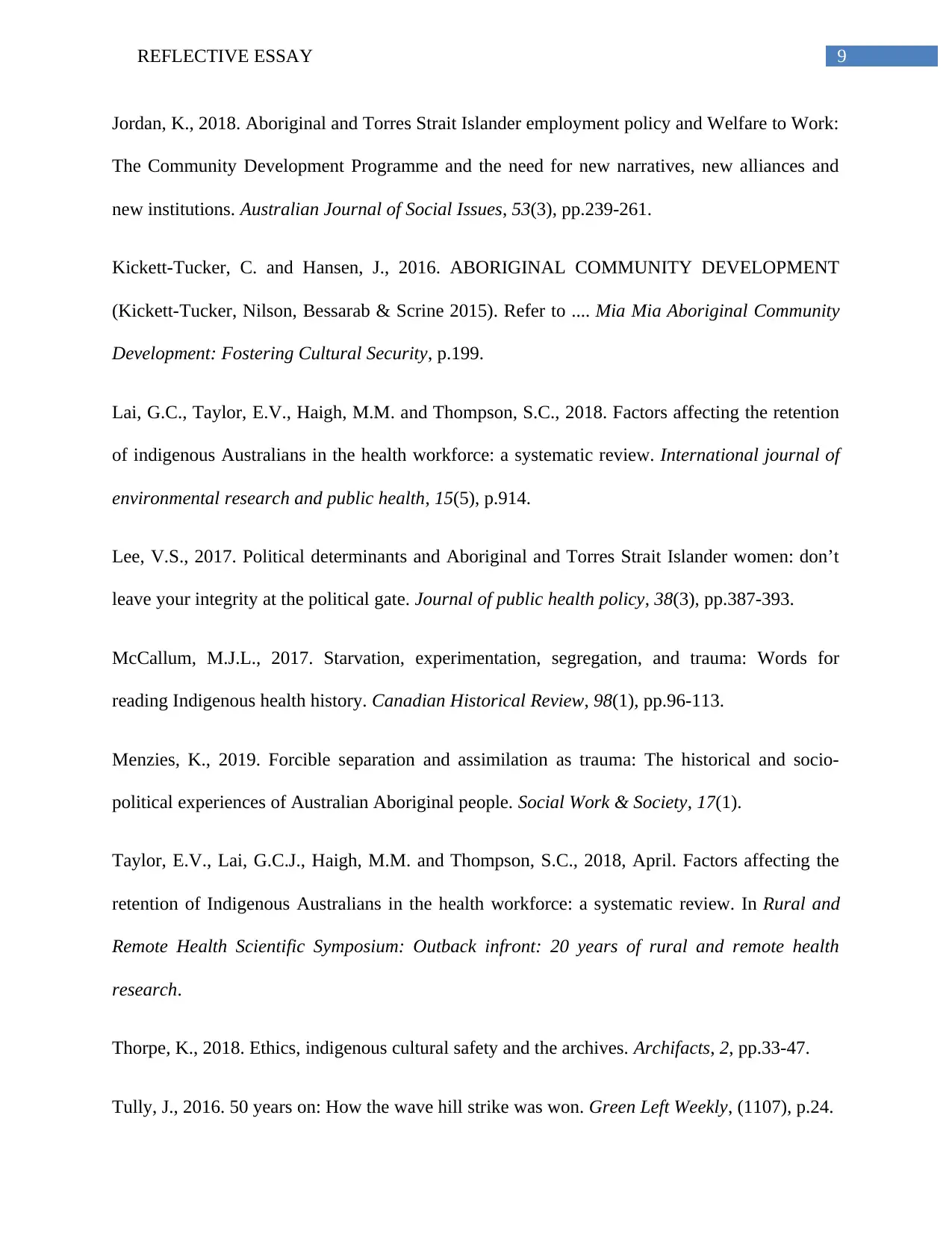
9REFLECTIVE ESSAY
Jordan, K., 2018. Aboriginal and Torres Strait Islander employment policy and Welfare to Work:
The Community Development Programme and the need for new narratives, new alliances and
new institutions. Australian Journal of Social Issues, 53(3), pp.239-261.
Kickett-Tucker, C. and Hansen, J., 2016. ABORIGINAL COMMUNITY DEVELOPMENT
(Kickett-Tucker, Nilson, Bessarab & Scrine 2015). Refer to .... Mia Mia Aboriginal Community
Development: Fostering Cultural Security, p.199.
Lai, G.C., Taylor, E.V., Haigh, M.M. and Thompson, S.C., 2018. Factors affecting the retention
of indigenous Australians in the health workforce: a systematic review. International journal of
environmental research and public health, 15(5), p.914.
Lee, V.S., 2017. Political determinants and Aboriginal and Torres Strait Islander women: don’t
leave your integrity at the political gate. Journal of public health policy, 38(3), pp.387-393.
McCallum, M.J.L., 2017. Starvation, experimentation, segregation, and trauma: Words for
reading Indigenous health history. Canadian Historical Review, 98(1), pp.96-113.
Menzies, K., 2019. Forcible separation and assimilation as trauma: The historical and socio-
political experiences of Australian Aboriginal people. Social Work & Society, 17(1).
Taylor, E.V., Lai, G.C.J., Haigh, M.M. and Thompson, S.C., 2018, April. Factors affecting the
retention of Indigenous Australians in the health workforce: a systematic review. In Rural and
Remote Health Scientific Symposium: Outback infront: 20 years of rural and remote health
research.
Thorpe, K., 2018. Ethics, indigenous cultural safety and the archives. Archifacts, 2, pp.33-47.
Tully, J., 2016. 50 years on: How the wave hill strike was won. Green Left Weekly, (1107), p.24.
Jordan, K., 2018. Aboriginal and Torres Strait Islander employment policy and Welfare to Work:
The Community Development Programme and the need for new narratives, new alliances and
new institutions. Australian Journal of Social Issues, 53(3), pp.239-261.
Kickett-Tucker, C. and Hansen, J., 2016. ABORIGINAL COMMUNITY DEVELOPMENT
(Kickett-Tucker, Nilson, Bessarab & Scrine 2015). Refer to .... Mia Mia Aboriginal Community
Development: Fostering Cultural Security, p.199.
Lai, G.C., Taylor, E.V., Haigh, M.M. and Thompson, S.C., 2018. Factors affecting the retention
of indigenous Australians in the health workforce: a systematic review. International journal of
environmental research and public health, 15(5), p.914.
Lee, V.S., 2017. Political determinants and Aboriginal and Torres Strait Islander women: don’t
leave your integrity at the political gate. Journal of public health policy, 38(3), pp.387-393.
McCallum, M.J.L., 2017. Starvation, experimentation, segregation, and trauma: Words for
reading Indigenous health history. Canadian Historical Review, 98(1), pp.96-113.
Menzies, K., 2019. Forcible separation and assimilation as trauma: The historical and socio-
political experiences of Australian Aboriginal people. Social Work & Society, 17(1).
Taylor, E.V., Lai, G.C.J., Haigh, M.M. and Thompson, S.C., 2018, April. Factors affecting the
retention of Indigenous Australians in the health workforce: a systematic review. In Rural and
Remote Health Scientific Symposium: Outback infront: 20 years of rural and remote health
research.
Thorpe, K., 2018. Ethics, indigenous cultural safety and the archives. Archifacts, 2, pp.33-47.
Tully, J., 2016. 50 years on: How the wave hill strike was won. Green Left Weekly, (1107), p.24.
Paraphrase This Document
Need a fresh take? Get an instant paraphrase of this document with our AI Paraphraser
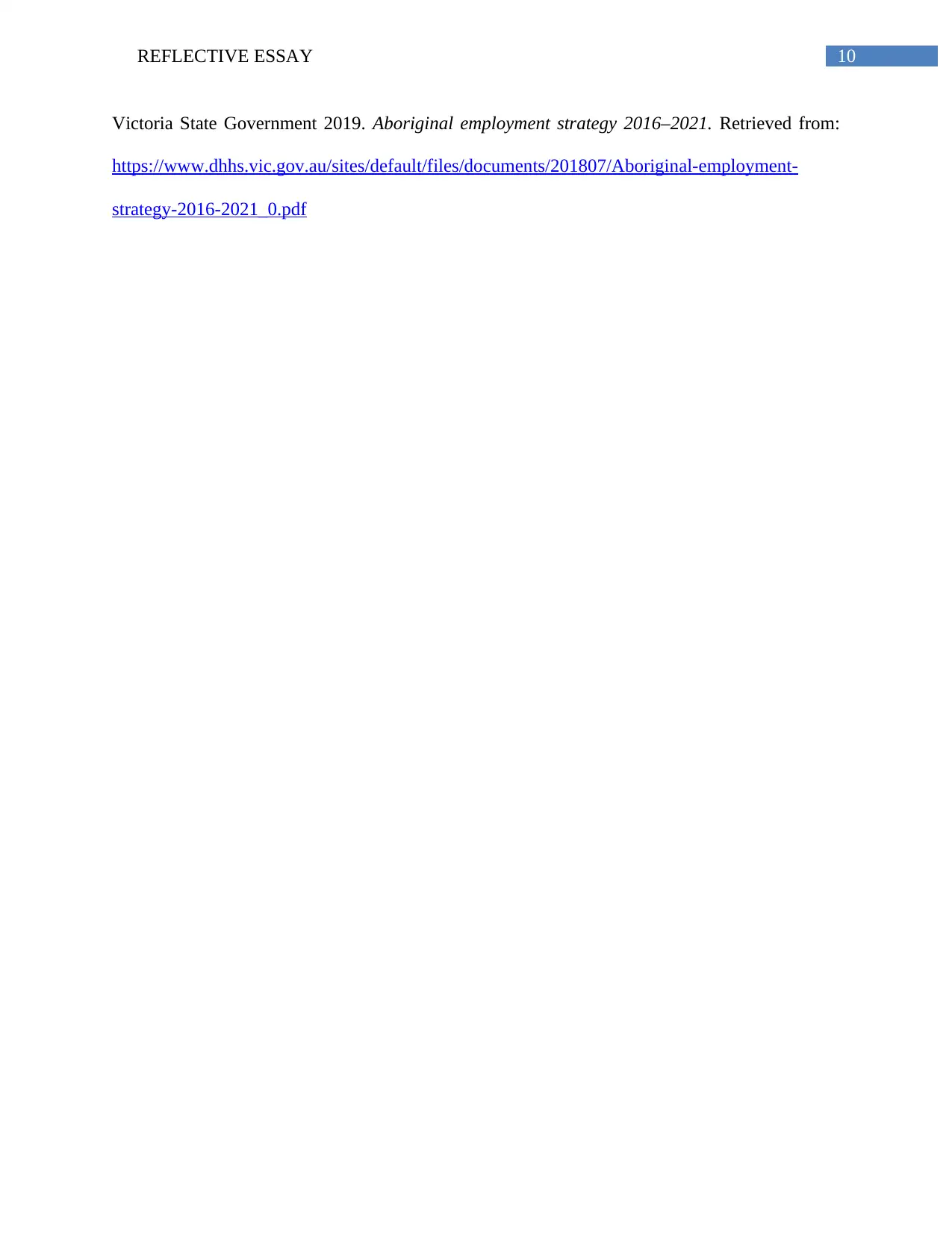
10REFLECTIVE ESSAY
Victoria State Government 2019. Aboriginal employment strategy 2016–2021. Retrieved from:
https://www.dhhs.vic.gov.au/sites/default/files/documents/201807/Aboriginal-employment-
strategy-2016-2021_0.pdf
Victoria State Government 2019. Aboriginal employment strategy 2016–2021. Retrieved from:
https://www.dhhs.vic.gov.au/sites/default/files/documents/201807/Aboriginal-employment-
strategy-2016-2021_0.pdf
1 out of 11
Related Documents
Your All-in-One AI-Powered Toolkit for Academic Success.
+13062052269
info@desklib.com
Available 24*7 on WhatsApp / Email
![[object Object]](/_next/static/media/star-bottom.7253800d.svg)
Unlock your academic potential
Copyright © 2020–2025 A2Z Services. All Rights Reserved. Developed and managed by ZUCOL.





